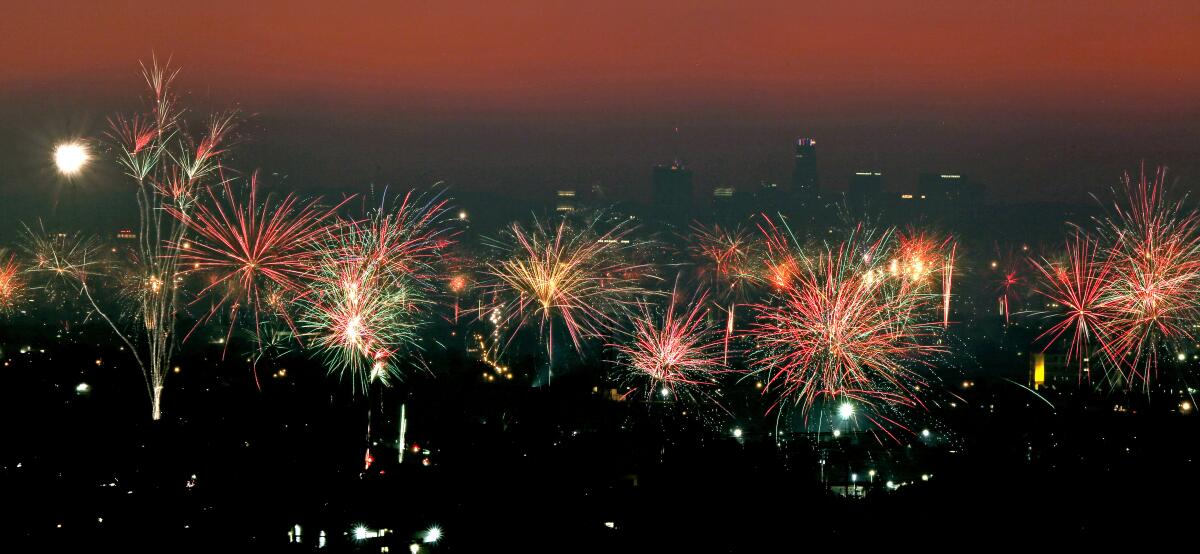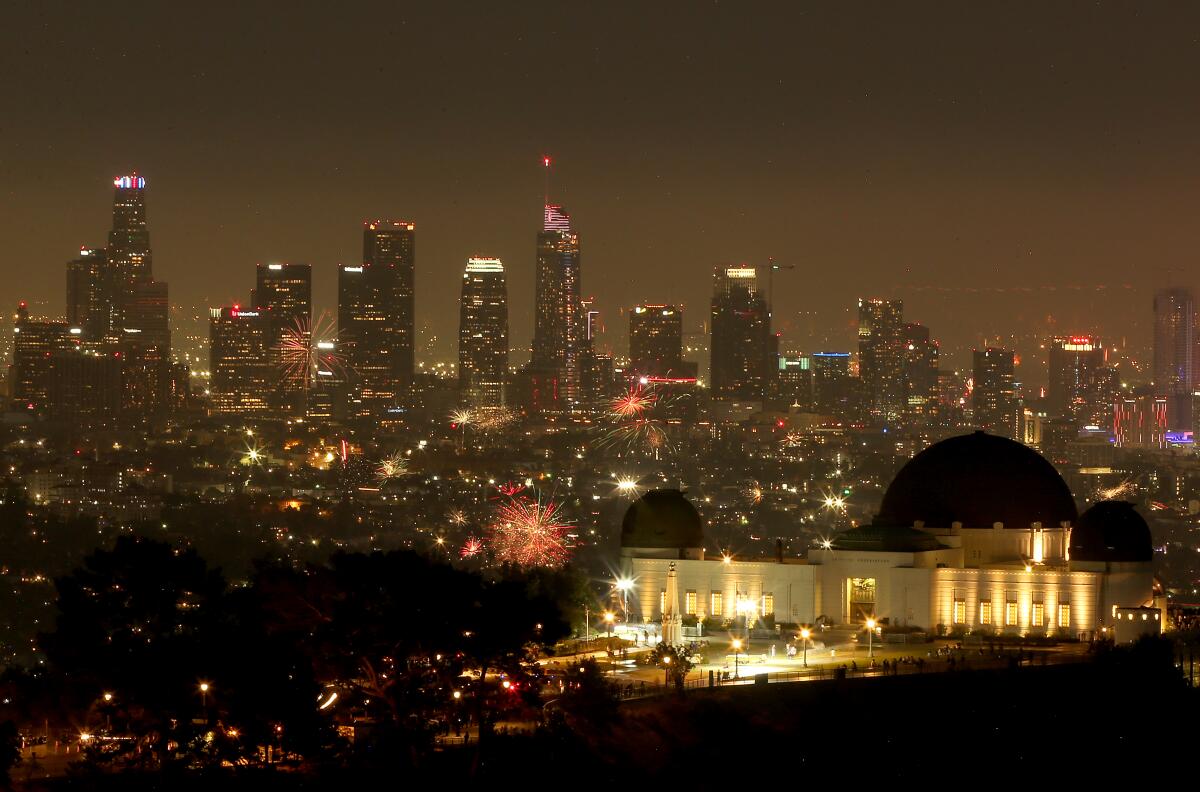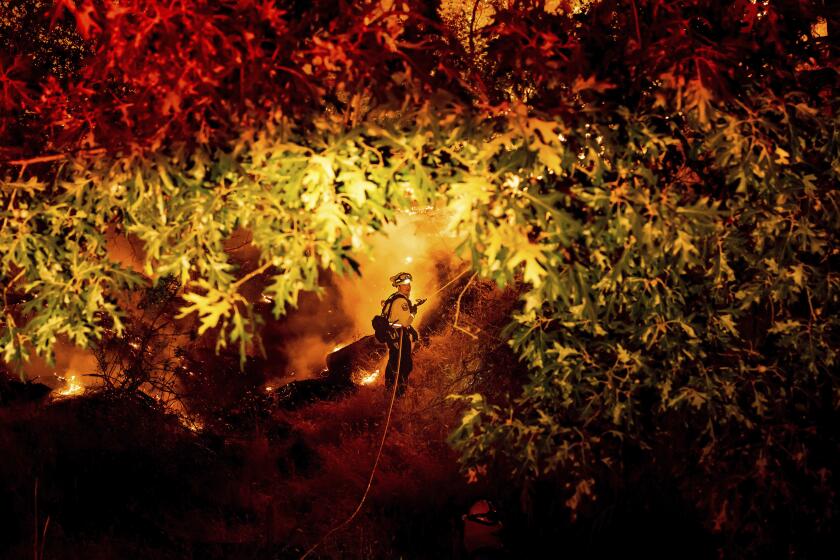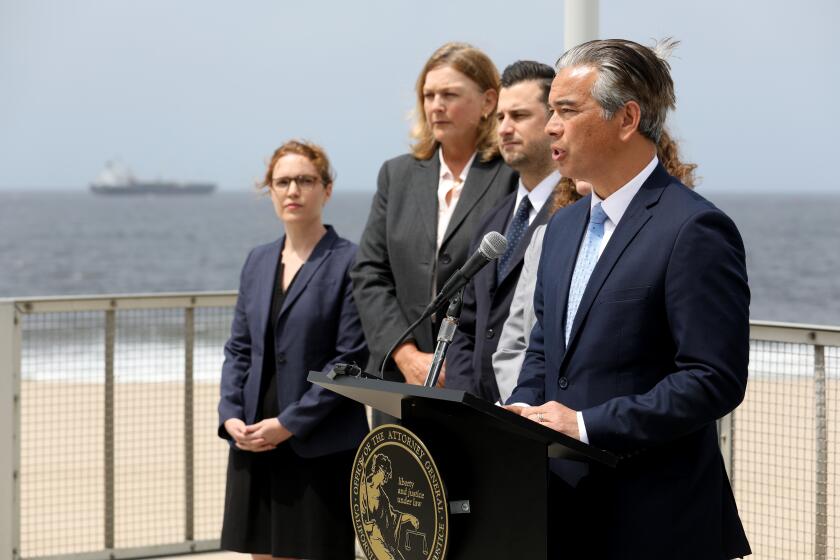Poor air quality lingering in Los Angeles after July 4 firework shows

- Share via
Air quality dropped considerably after hundreds of Fourth of July firework shows and smaller sets lighted up skies across the Los Angeles region Monday and remained at unhealthy levels into Tuesday morning for many areas.
The South Coast Air Quality Management District issued a particulate advisory through Tuesday for much of Southern California, from Los Angeles and into the Coachella Valley, because of fireworks, which emit high levels of particulate matter and metal air pollutants.
“Fine particulate matter levels on July 4 and July 5 are typically among the worst days of the year in the South Coast Air Basin,” the advisory said. “The smoke and combustion products from fireworks add to the fine particles already present in the basin that are primarily caused by motor vehicles, as well as fugitive dust and industrial emissions.”
The advisory warned that using personal or backyard fireworks “may lead to localized fine particulate matter concentrations above observed regional levels.”

Fireworks on the previous two Fourths of July set record-high air pollution levels for the holiday.
The aftermath from this year’s fireworks doesn’t yet appear quite as bad as in 2020 or 2021, said Scott Epstein, air quality assessment program supervisor at the AQMD. The effect of fireworks on air quality is typically a function of the intensity or number of fireworks, as well as the weather on July 5, he said.
“It looks a little bit cleaner than last year, but I hesitate to use the word ‘clean,’ because it’s not clean,” Epstein said. He said wildfires are the only other events that can compromise air quality as fireworks do.
Out-of-control Electra fire threatens more than 1,000 structures and prompts multiple evacuation orders in Amador and Calaveras counties.
“You need a big wildfire to get to those levels,” Epstein said.
He said it’s hard to fully compare this year’s air quality with those of prior holidays until the end of Tuesday.
Areas outside the city of Los Angeles — from Thousand Oaks to El Monte and Riverside — had unhealthy air quality levels Tuesday morning, according to data from the AQMD. Parts of downtown L.A. are still considered unhealthy for sensitive groups, but most of South L.A. had recovered from the fireworks pollution as of 10 a.m.
Epstein said that as of Tuesday morning, west-to-east winds had moved most pollutants inland into the San Fernando and San Gabriel valleys and the Inland Empire. He expected the worst of the pollution should be gone by Wednesday, when the agency’s advisory expires.
“We are expecting a fairly normal day tomorrow, but normal doesn’t mean clean this time of year,” Epstein said. “We can still have high ozone levels in the summer.”
A 42-year-old man who was handling a suspected illegal firework was killed in an explosion Monday night in Montebello, police said.
For most of Monday, measurements on the U.S. Air Quality Index hovered around moderate or good in the central Los Angeles area, but only through 9 p.m. Starting then — just after most firework shows — air quality metrics worsened, dropping to “unhealthy for sensitive groups,” and by 10 p.m., the measurement dropped two index levels into “very unhealthy,” data show.
That level remained for the next three hours, improving to unhealthy for most of Tuesday morning — a category still three levels worse than Monday’s pre-evening fireworks, according to the Air Quality Index.
According to the index, during the same time frame, north Orange County saw a similar shift, moving from good or moderate air quality before 10 p.m. to unhealthy or very unhealthy afterward. But by 4 a.m. Tuesday, that area’s air quality had recovered back to moderate, data show.
The west San Gabriel Valley region followed a similar trend during the evening’s fireworks, moving from relatively good air quality measurements Monday evening into unhealthy or very unhealthy by late Monday and into Tuesday.
Experts say U.S. Supreme Court ruling is not likely to unravel California’s ambitious climate goals to eliminate its carbon footprint by 2045.
But some areas not far from the coast, such as Culver City, didn’t record any drastic changes in air quality, remaining at healthy levels throughout Monday evening and into Tuesday. Others more to the south, including Long Beach and Hermosa Beach, recovered quickly from fireworks, though those areas still recorded unhealthy levels of air soon after 9 p.m. By Tuesday morning, most of the coast and southern L.A. were back to healthy or moderate air quality levels.
The South Coast Air Quality Management District warned residents that breathing in fine particulate matter can lead to “cardiovascular and respiratory health effects,” such as coughing, difficulty breathing, decreased lung function or even heart attacks.
“It’s pretty hard to tell when your air is polluted,” Epstein said. “It’s a little different with wildfires because you can smell the wood smoke. … So it’s really important that people stay informed of that and check their air quality.”
The AQMD recommends people stay indoors when air quality is poor, close windows and run air conditioning or air purifiers.
More to Read
Sign up for Essential California
The most important California stories and recommendations in your inbox every morning.
You may occasionally receive promotional content from the Los Angeles Times.

















